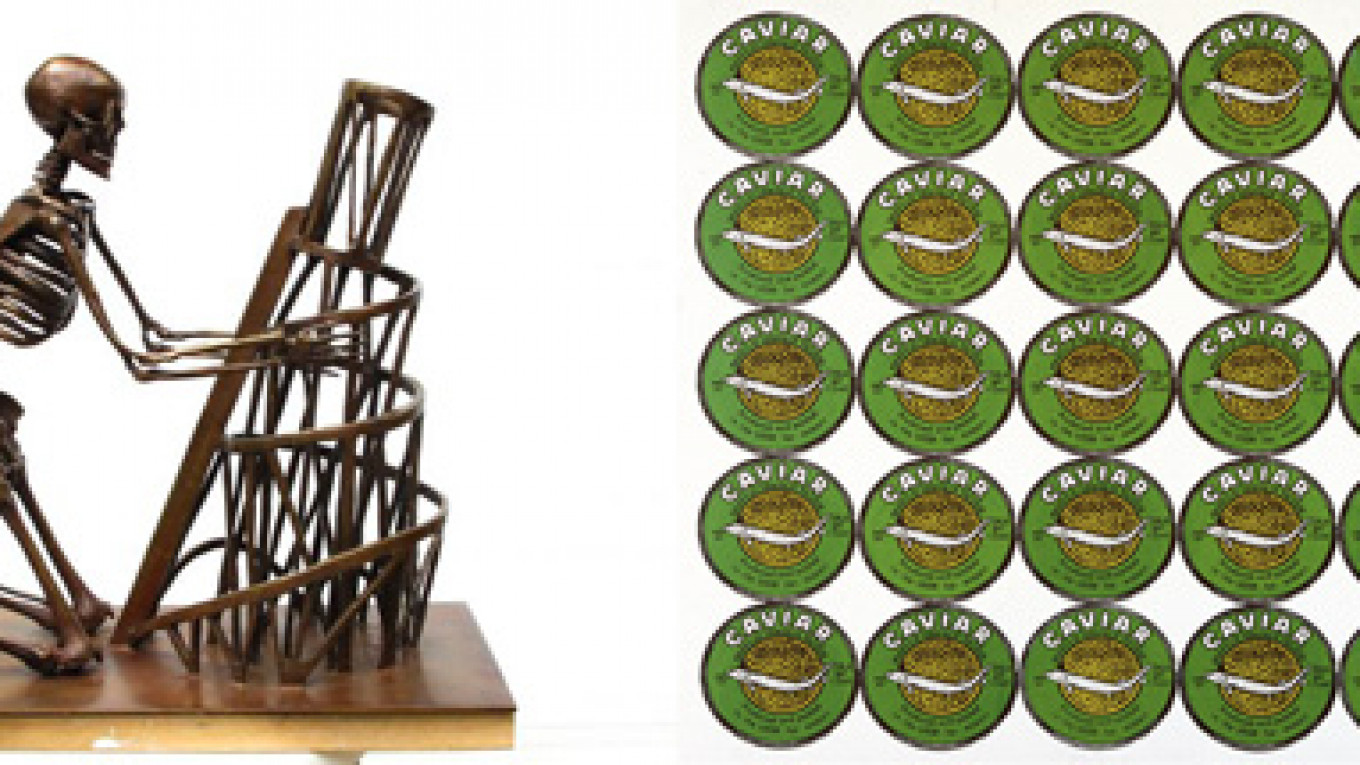Soviet-era artist Alexander Kosolapov shot to popularity after his move to New York in 1975, drawing ironic parallels between Soviet communism and American materialistic culture, combining the imagery from both in his work.
He graced London's Saatchi Gallery at the beginning of the year, lending his classics — including a Pop Art style arrangement of Russian caviar tins — to an exhibition of Moscow art from the 1960s to the 1980s.
He is now preparing to take his more modern sculptures to Vallois Gallery on Paris' Rue De Seine, a street famous for situationist theorist Guy Debord's "Ne travaillez jamais" (don't ever work) graffiti, where they will be on display from autumn.
Visitors will be able to see Mickey Mouse sharing a conversation with Jesus, Tatlin's Tower leaning away from the clutches of a skeleton, and a Mercedes sporting an onion dome.
However, his Soviet-era canvases still resonate profoundly as a lingering reminder of similar visuals used by both the US and Russia while they were still in many ways opposed. The most famous was his "Lenin — Coca Cola" display on New York's Times Square in 1982, in which a billboard depicted the Communist leader as a Coca-Cola advert.
Kosolapov recognizes how his experiences of both the United States and Russia lent themselves to his productions, and enabled him to further the movement of his "Sots Art" style internationally.
"In some ways we are very similar, but it was just different cultures," he said. "We are like brothers. I was very fortunate to find a way how the different cultures corrupted each other — Lenin, Coca Cola — 'it's the real thing' — I could put them together," Kosolapov said, mentioning the early 1970s "Sots Art" movement, of which he remains a firm advocate.
"Sots Art," or Socialist art was a form of Soviet pop art conceived by two conceptual artists named Vitaly Komar and Alexander Melamid, who called themselves a movement in their own right. "Sots Art" combined socialist realism with some dadaist elements, resulting in some very humorous pieces.
"American Pop Art was influenced by consumerist culture — materialistic culture — while Sots Art was inspired by ideological culture," he said. "It looks like we were working in the same direction," he stated, listing other influences in his vast array of work.
"I had the influence of avant-garde," Kosolapov stated, calling the movement "fascinating" and "perhaps the best cultural product of Russia."
"I love Picasso … Duchamp … many others, but then I decided to immigrate to America and got immersed in American culture. I became influenced by Warhol of course — definitely his books and writing," he added.
Duchamp's influence is evident in Kosolapov's collection of "suprematist urinals" produced after his move in the late 1980s. Their geometric designs clearly allude to Kazimir Malevich, best known for founding suprematism.
Despite analysts of Russian art detecting criticism in Kosolapov's work, retrospectively he does not believe he was being critical, but thought-provoking instead.
"I don't think it was criticism — it was the same with Warhol. He was not criticizing Campbell's Soup or pictures of superstars like Marilyn Monroe — it was … to show their cultural position — it's the same with me," he said, describing the images used as "icons."
"Art is not criticizing or publicizing. Art is subliminal. My art is littered with irony … but not critical," he affirmed.
While he knew of Warhol prior to his departure for American soil, he still had little idea what to expect of the country in the 1970s.
"I didn't have any concept about America … when you're born into the Soviet system it's is very claustrophobic. Nowadays, in Russia, many people speak English — there's the internet and more cultural exchange. But in 1975 we didn't know anything about America. For me it was a completely new world," he said.
The similarities between the visual cultures he found on arrival were countered by niggling differences in the objects they were built on.
"I used images from a different context," Kosolapov recalled. "American democracy has roots in consumer culture — Coca Cola, the poor man, the rich man — they're using the same Coca Cola," he said, underlining the difference from iconic designs in his homeland.
"It doesn't matter how much money you've got — Coca Cola is the same product. In Russia — you consume caviar — well, only the rich people can eat caviar," he said.
"It's not horizontal, it's vertical. We have … a sector who have everything, they have a yacht, they eat caviar, but poor people …" he trailed off. "This is the opposite … Russian brothers support the idea of a vertical political system in Russia, not democracy."
Kosolapov continues to return to Russia despite technically residing in the US nowadays. "I still have several interests in Moscow," he said, "I sometimes participate in exhibitions there," he mentioned, adding that he keeps a Russian passport and retains his citizenship.
Displays of his work within Russia haven't always been well-received. In the early 2000s a collection of canvases entitled "This is my blood | This is my body" roused fury among Orthodox believers. He positioned Jesus alongside McDonalds, and again, Coca Cola logos.
"There was public condemnation of my exhibition," he said. "My work was called extremist...I was not myself called extremist," he clarified, "but I had to explain to a court the cultural and political meaning of my work."
Since then, he has branched out more solidly into sculpture, converting the McDonalds "M" into a pair of wings for an angelic looking jean-clad boy and giving the iconic "Worker and Kolkhoz Woman" landmark the heads of Micky and Minnie Mouse.
"I don't know if you are familiar with my new pieces," he pondered modestly, "but I try to update my work for the new reality as well."
A Message from The Moscow Times:
Dear readers,
We are facing unprecedented challenges. Russia's Prosecutor General's Office has designated The Moscow Times as an "undesirable" organization, criminalizing our work and putting our staff at risk of prosecution. This follows our earlier unjust labeling as a "foreign agent."
These actions are direct attempts to silence independent journalism in Russia. The authorities claim our work "discredits the decisions of the Russian leadership." We see things differently: we strive to provide accurate, unbiased reporting on Russia.
We, the journalists of The Moscow Times, refuse to be silenced. But to continue our work, we need your help.
Your support, no matter how small, makes a world of difference. If you can, please support us monthly starting from just $2. It's quick to set up, and every contribution makes a significant impact.
By supporting The Moscow Times, you're defending open, independent journalism in the face of repression. Thank you for standing with us.
Remind me later.






